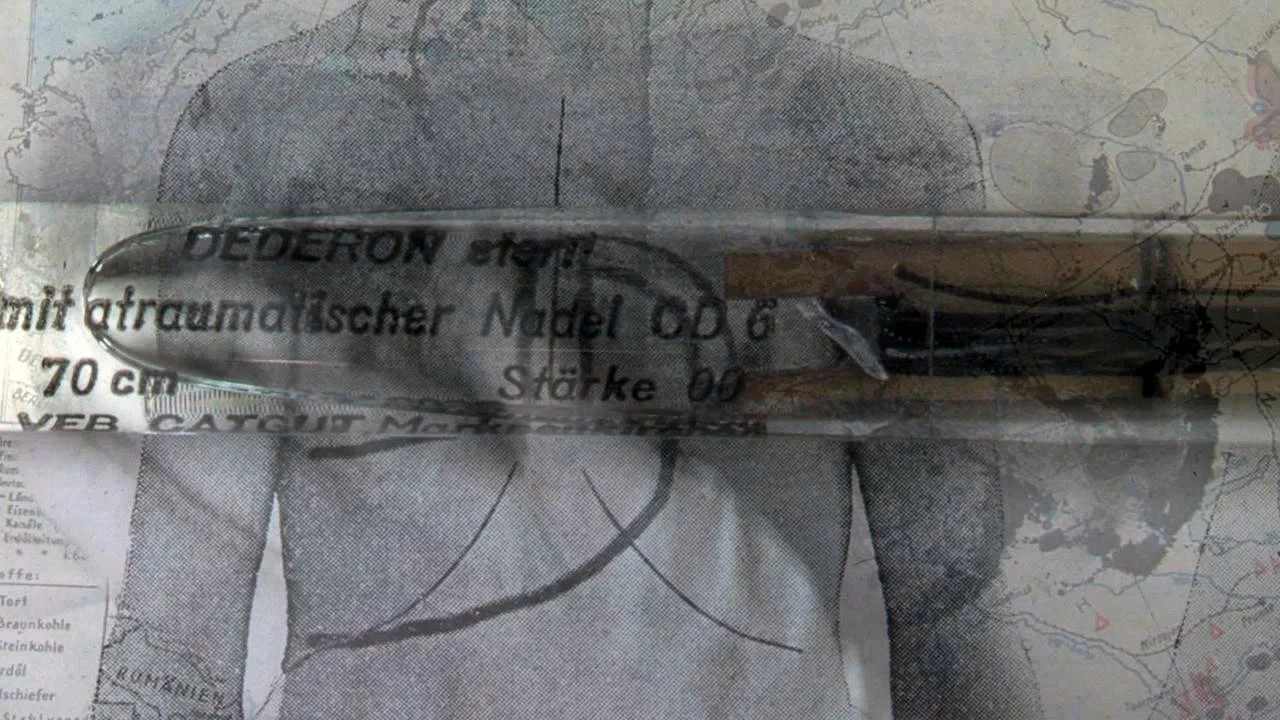Sustenazo (Lament II)
above: excerpt from Sustenazo (Lament II), 2010-2012, part 3, high definition video, sound composition (to hear the sound press the sound icon located in the lower right corner of the moving image)
SUSTENAZO (Lament II)
2010-2012
high definition video and sound composition, duration: 27 minutes 30 seconds, limited edition, 3 + 2 AP
series of video stills, dimensions variable, limited edition, 3 + 2 AP
installation: medical books, high literature books, maps, music scores, medical instruments, by German authors and published in Germany before 1945, artist’s drawings on book pages
performance: the artist dressed in a long black gown lies on top of the archival materials of the installation and draws around her body using charcoal and graphite sticks, with her eyes closed
collections:
Patricia and Phillip Frost Art Museum, Miami, Florida (curator Julia P. Herzberg)
Centre of Contemporary Art Ujazdowski Castle, Warsaw, Poland (curator Milada Slizińska)
above: excerpt from Sustenazo (Lament II), 2010-2012, part 2, high definition video, sound composition. View of the work as a solo exhibition at Patricia & Philip Frost Art Museum, Miami, 2014
below: selected video stills, limited edition, 3 + 2AP
Credits
Written, directed, choreographed, filmed, recorded and edited by Monika Weiss
Polish voice: Krystyna Zalewska
German voices: Barbara Caveng, Heiko Daxl, Andreas Matthias Grimm, Kristina Hahn, Max Hannes, Anna Hope, Cordula Hufnagel, Maja Linke, Ralf Niebuhr, Christoph Rasch, Bele Papperitz-Hannes, Wolfgang Strankowski, and Jens Umlauf
countertenor: Anthony Roth Costanzo
movement performer: Gillian Lipton
texts:
Krystyna Zalewska, words spoken in conversation with Monika Weiss, recorded in 2009 [spoken in Polish]
Johann Wolfgang von Goethe, Faust, Der Tragödie zweiter Teil (Faust, Second Part of the Tragedy),1832 [performed in German]
Paul Clean, Todesfuge (Death Fugue) originally written in Romanian in 1944, put in its final form in 1945, then translated into German in 1948 [performed in German]
Artist Statement
Sustenazo (meaning in Greek, “to sigh, to lament inaudibly together”) explores visual and musical aspects of the ancient ritual of Lament and its historical connection to feminine expression, especially as contrasted with the notion of the heroic myth within the narrative of war. Sound compositions incorporate voices of surviving witnesses of the Ujazdowski Hospital’s expulsion, along with German voices reading passages from Goethe’s Faust.
Using the specific historical example of a crime committed on a hospital - one of many painful atrocities routinely committed within the politics of war - Sustenazo speaks to the essence of a hospital as a center for healing, juxtaposed to the oppression of all human rights throughout time. Sustenazo is a poetic environment built from layers of images, objects and sounds opening a potential space for each viewer to respond to their own assumptions and conclusions.
- Monika Weiss
Essay Excerpts
The multiple meanings of Sustenazo (Lament II) are evoked through a sequence of imagery featuring the torso of a woman moving slowly backward and forward in opposite directions, embodying in her gestures the expression of lament. Against this imagery are those of old maps of Europe, medical instruments used before and during World War II, a medical photograph of a woman’s chest, and a white-gloved hand moving gently over it. The visual narrative is dramatically enhanced by the artist’s musical composition, which includes recitations of literary texts.
- Julia P. Herzberg in Monika Weiss-Sustenazo (Lament II), Museum of Memory and Human Rights, Santiago, Chile, 2012
Sustenazo (Lament II) arose out of events from a different geography, Warsaw in Poland, and a different time, the closing years of the Second World War. Yet its gestures come home to us and its operations are recognizable. The suffering of our own history, the history shown here in this museum of memory in Santiago, Chile, connects in this work with much older sufferings: we are reminded that the gestures of loss have been with us since the beginnings of our culture. In summoning them, we draw upon a common experience, not constrained by places and dates. We explore this experience— and with it, we may hope, the dimensions of our own grief.
- Adriana Valdès in Monika Weiss-Sustenazo (Lament II), Museum of Memory and Human Rights, Santiago, Chile, 2012
Review Excerpt
Monika Weiss recalls the horror of the event resorting to literary texts, direct testimonies of survivors, and images of the time. She does so using a cinematographic language and fragmented and suggestive elements which do not pretend to evoke a historical event but an emotion, a feeling.
- Juan Jose Santos in Arte al Dia, 2013
Exhibitions
Monika Weiss-Sustenazo, Centre for Contemporary Art Ujazdowski Castle, Warsaw, March-May 2010, curated by Milada Slizińska
Monika Weiss-Sustenazo, TAZ Temporary Art Zone, Potsdam, July 2010, curated by Erik Bruinenberg
Monika Weiss-Sustenazo (Lament II), Museum of Memory and Human Rights, Santiago, Chile, December, 2012 - April, 2013, curated by Julia P. Herzberg in collaboration with María José Bunster
Monika Weiss-Sustenazo (Lament II), Patricia & Phillip Frost Art Museum of Art, Miami, February - April, 2014, curated by Julia P. Herzberg
Monika Weiss-Sustenazo (Lament II), Goethe Institut/Max Mueller Bhavan, New Delhi, April 2015, curated by Amit Mukhopadhyay
The Poetics of Absence, 1x1 Gallery, Dubai, United Arab Emirates, January - February, 2017, curated by Cristiana de Marchi
PublicationS
Monika Weiss-Sustenazo (Lament II), Museum of Memory and Human Rights, Santiago, Chile, 2012
Ricardo Brodsky, Trampas de la Memoria, FLACSO, Chile, 2018
Monika Weiss-Nirbhaya, Centre of Polish Sculpture in Orońsko, 2021











![[3] Monika Weiss Sustenazo (Lament II) Museo de la Memoria.jpg](https://images.squarespace-cdn.com/content/v1/5c0fb214266c07ae7ee9d1f0/1600563620590-97UVT4ZC2A1RFS52Q001/%5B3%5D+Monika+Weiss+Sustenazo+%28Lament+II%29+Museo+de+la+Memoria.jpg)









